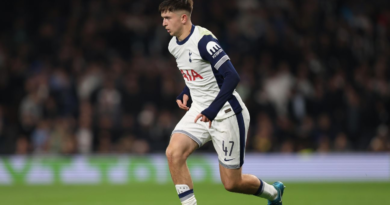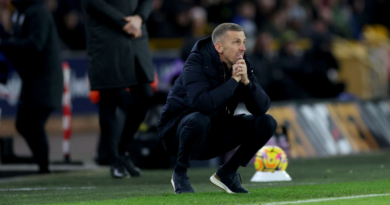All eyes on Augusta: How major pairings are handled in a post-LIV world
AUGUSTA, Ga. — Sometimes a late night is required. Other times it’s an early morning. But by now, Jeff Hall knows the drill.
As the USGA manager overseeing rules who has been working on U.S. Open pairings since 2006, Hall’s task is relatively straightforward: turn a field of 156 players into 52 threesomes. The process of doing so, however, is more complex. Some might find it tedious, but Hall, well, he finds it fun.
“2018! That was the best one. Daniel Berger, Andrew ‘Beef’ Johnson, and nobody can figure out why we put them with Kevin Chappell,” Hall said in a recent phone call, laughing as he recounted the meat-centric grouping. “Well, at least at that time, Ruth’s Chris was one of his primary sponsors on his clothing. Ruth’s Chris Steakhouse.”
Hall’s voice skips from octave to octave as he explains this part of his job, displaying a kind of joy for matching hometowns and colleges and whatever connections he can concoct that makes one think he’d thrive as a camp counselor tasked with the similar, but different, job of picking a handful of individuals to spend an extended amount of time together. In this case, that time is 36 holes and about 12 hours.
“We try to build out that puzzle as efficiently and as effectively as we can and yet still trying to have a little bit of fun along the way,” Hall said. “We try to do some themes, but they still gotta fit together well. You’re trying to be thoughtful about putting guys together. Sometimes it’s a bombers group, or a few of the best putters, or maybe some Ryder Cup connections.”
Back in the day, Hall and former USGA president Mike Davis used to lock themselves in a room from 5 in the morning until noon, 156 3-by-5-inch note cards laid out in front of them with the names of every player, their hometowns and any other fun fact or description that could make them easy to pair. Last year, Hall sat in a room with Brent Paladino, the USGA’s director of administration, to do the same thing, except now they’re not writing things with pencil or faxing results; they’re inputting them into a computer. Still, they began at 7 p.m. and ended around midnight.
With pairings at majors, there’s many things to consider: pace of play, TV network preferences (featured groups!), broadcast windows (you want Hideki Matsuyama to ideally be playing at a time when his home country of Japan can watch), and just the sheer amount of players who need to play in one day of golf as well as how the tournament logistics will handle the different waves.
Now, at least to the public paying attention, there’s another factor: How will LIV Golf players be paired?
With the four major tournaments now being the exclusive stages where PGA Tour golfers and LIV golfers will meet, Hall and the PGA Championship’s Kerry Haigh detailed how they foresaw each tournament would deal with the task.
“I think they earned the right to be there,” Hall said. “You can’t hide the fact that Brooks [Koepka] has won four majors, right? That is true. And I think you would want to find players that are again in a similar standard to pair him with. We will endeavor to do that, so we’re not interested in segregating players who play on one tour versus another.”
On Tuesday, Augusta National — which, alongside the R&A, did not make a representative available for this story — released the long-awaited pairings for the first major involving both tours. LIV players were notably not paired with one another save for one exception: Jason Kokrak and Talor Gooch. Only Cameron Smith (who is the sixth-ranked player in the world) was paired with another top-20 player — Sungjae Im — but neither Smith nor any other LIV players will be in the featured groups.
Hall and Haigh said they would be watching to see what Augusta did. But as far as LIV goes, they have a hard time seeing how they will take any different approach to the process.
“I don’t think we want to create controversy by putting three players together on a piece of paper,” Hall said. “We believe the best stories at the U.S. Open will be borne out on the golf course by the best players in the world, doing what they do best. We don’t need to create some controversy based on who are the three players that we grouped together.”
“I don’t think we would do anything differently than we have in the past in that regard,” Haigh said. “All pros play the same game, and we’ve got to be proud of the strength of the field that we have for the PGA Championship as we always are.”
If Hall and the USGA relish telling a story with their homespun pairings, then Haigh and the PGA would rather do the opposite. Their approach is more scientific, and whereas Hall would love to pair players from the same countries, regions or colleges, Haigh said the PGA instead wants to split those players up.
“The aim of a group is to be mixed and varied and, in a way, not controversial. You want to kind of mix them up,” Haigh said. “So it’s different countries, different nationalities, different states playing together. And yeah, we do look to the previous majors’ and the groupings the year before, to be honest, to kind of make sure the same three players aren’t playing together again.”
In fact, Haigh & Co. have gone through multiple computer systems that randomize the field for them. The entire field gets put into the system, which spits out pairings before Haigh and his team go through them with preferences: splitting up the PGA professionals, setting up featured groups based on world rankings, ensuring some variety, and then also doing their traditional group of the past three major winners. This year, because the PGA Championship is in May, that group would be Matt Fitzpatrick, Scottie Scheffler and LIV member Smith.
“I would think that group won’t be affected by [LIV],” Haigh said. “The champions group will be the champions group.”
Despite the fact that both Haigh and Hall don’t foresee changing things up, they both said there’s usually someone in the process who provides feedback on player relationships and whether a certain player should not be paired with another. For the USGA, that individual was Jason Gore, who handled player relations until leaving for a similar role at the PGA Tour in 2022. Gore — and now Scott Langley — would provide Hall with information about certain players who might not be getting along.
“A few years ago, it was no secret that Bryson [DeChambeau] and Brooks were not going to dinner regularly,” Hall said. “Well, while it might have been, oh, let’s put those together and really, you know, we’ll generate a lot of media hits if we did it, but wait a minute, why would we do that to past champions at the U.S. Open? Why would we do that to those guys? That doesn’t make a lot of sense.”
Once in a while, Hall says he’ll hear from a player after a tournament asking if he ticked him off to get the pairing he did. Other times, it’s a player saying he really enjoyed his pairing. Haigh added that once every few years, they’ll hear from the PGA Tour about specific player pairings that might be avoided and concurs with the notion that the goal of pairings is to be as uncontroversial and as much of a nonstory as possible beyond generating excitement for the tournament.
“It’s a major championship and you want players to be focused on their game and not on who they are paired with,” Haigh said.
The reality, though, is that this year, where LIV players ended up in the draw and with whom they’ll play on Thursday and Friday will be a focal point of the discussion. Even Rory McIlroy said Tuesday that the reality is he might get along better with some of the LIV players more than others.
“Look, it’s a narrative and a storyline,” McIlroy said. “But the Masters and the four major championships sit above all that noise.”
Even if pairings are kept straightforward and as uncontroversial as possible, both Hall and Haigh made sure to point out that they can only control Thursday and Friday. Once Saturday and Sunday arrive, anything is possible.




